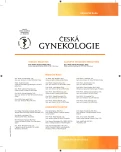Implementation of arrays in first trimester prenatal diagnosis
Authors:
M. Trková; M. Putzová; V. Bečvářová; J. Horáček; I. Soldátová; L. Krautová; M. Sekowská; J. Hodačová; L. Hnyková; E. Hlavová; D. Smetanová; D. Stejskal
Authors‘ workplace:
Gennet, Centrum lékařské genetiky a reprodukční medicíny, Praha, vedoucí lékař MUDr. D. Stejskal
Published in:
Ceska Gynekol 2015; 80(3): 176-180
Overview
Objective:
Array technology in chorionic villus sampling (CVS) – analysis of clinical benefit and a proposal of a more effective 1st trimester genetic testing policy.
Design:
Retrospective study.
Setting:
Gennet, Center of Medical Genetics and Reproductive Medicine, Prague.
Material and methods:
Total of 913 CVS were performed at Gennet between 2010–2014. All 913 samples were tested by QF-PCR rapid test for aneuploidy of chromosomes 13, 18, 21, X and Y and karyotyping following standard long term culture. Microarray analysis (Illumina HumanCytoSNP12 v2.1) was performed on 179 samples with normal result from both – QF-PCR and karyotyping.
Results:
At 229 samples the common chromosomal aneuploidy was detected using rapid QF-PCR (25% from 911 successful rapid tests). Conventional karyotyping revealed 239 unbalanced chromosome aberrations (27% from 897 successful cultivations). 227/239 (95%) positive karyotypes confirmed QF-PCR finding of common aneuploidies. 10 unbalanced chromosome aberrations were not covered by rapid QF-PCR test. Microarray analysis of samples with normal result from both– QF-PCR and karyotyping– revealed 13 clinically relevant chromosome aberrations (7.5%).
Conclusion:
New policy for chorionic villi testing at Gennet was established. Based on evaluation of the results of karyotyping, array and QF-PCR and analysis of published data we decided to replace karyotyping by microarray analysis in all cases of foetuses with normal results from QF-PCR. More effective detection of pathological and clinically relevant chromosome aberrations in examined foetuses is expected.
Keywords:
CVS, prenatal diagnosis, QF-PCR, karyotype, array
Sources
1. ACOG Committee Opinion No. 581: The use of chromosomal microarray analysis in prenatal diagnosis. 2013, Obstet Gynecol, 122(6), p. 1374–1377.
2. Baptista, J., Mercer, C., Prigmore, E., Gribble, SM., et al. Breakpoint mapping and array CGH in translocations: comparison of a phenotypically normal and abnormal cohort. 2008, Am J Hum Genet, 82, p. 927–936.
3. Bečvářová, V., Hynek, M., Putzová, M., et al. [Application of SNP array method in prenatal diagnosis]. Ces Gynek, 2011, 76(4), p. 261–217.
4. Breman, A., Pursley, AN., Hixson, P., Ward, P., et al. Prenatal chromosomal microarray analysis in a diagnostic laboratory; experience with >1000 cases and review of the literature. Prenat Diagn, 2012, 32(4), p. 351–361.
5. De Wit, MC., Srebniak, MI., Govaerts, LC., et al. Additional value of prenatal genomic array testing in fetuses with isolated structural ultrasound abnormalities and a normal karyotype: a systematic review of the literature. Am J Ultrasound Obstet Gynecol, 2014, 43(2), p. 139–146.
6. Hahnemann, JM., Vejerslev, LO. European collaborative research on mosaicism in CVS (EUCROMIC) – fetal and extrafetal cell lineages in 192 gestations with CVS mosaicism involving single autosomal trisomy. Med Genet, 1997, 70(2), p. 179–187.
7. Putzová, M., Pecnová, L., Dvořáková, L., et al. OmniPlex--a new QF-PCR assay for prenatal diagnosis of common aneuploidies based on evaluation of the heterozygosity of short tandem repeat loci in the Czech population. Prenat Diagn, 2008, 28(13), p. 1214–1220.
8. Shaffer, LG., Rosenfeld, JA., Dabell, MP., Coppinger, J., et al. Detection rates of clinically significant genomic alterations by microarray analysis for specific anomalies detected by ultrasound. Prenat Diagn, 2012, 32(10), p. 986–995.
9. Srebniak, MI., Boter, M., Oudesluijs, GO., et al. Genomic SNP array as a gold standard for prenatal diagnosis of foetal ultrasound abnormalities. Mol Cytogenet, 2012, 5(1), p. 14.
10. Srebniak, MI., Mout, L., Van Opstal, D., Galjaard, RJ. 0.5 Mb array as a first-line prenatal cytogenetic test in cases without ultrasound abnormalities and its implementation in clinical practice. Hum Mutat, 2013, 34(9), p. 1298–1303.
11. Vanakker, O., Vilain, C., Janssens, K., Van der Aa N., et al. Implementation of genomic arrays in prenatal diagnosis: the Belgian approach to meet the challenges. Eur J Med Genet, 2014, 57(4), p. 151–156.
12. Van Opstal, D., de Vries, F., Govaerts, L., Boter, M., et al. Benefits and burdens of using a SNP array in pregnancies at increased risk for the common aneuploidies. Hum Mutat, 2014, doi: 10.1002/humu.22742. [Epub ahead of print].
13. Vestergaard, EM., Christensen, R., Petersen, OB., Vogel, I. Prenatal diagnosis: array comparative genomic hybridization in fetuses with abnormal sonographic findings. Acta Obstet Gynecol Scand, 2013, 92(7), p. 762–768.
Labels
Paediatric gynaecology Gynaecology and obstetrics Reproduction medicineArticle was published in
Czech Gynaecology

2015 Issue 3
Most read in this issue
- Prevention of preeclampsia – review
- The importance of irregular red cell antibodies screening and blood group antigens assessment in pregnant women
- Specific placental complications of monochorionic diamniotic twins born after 24 weeks of pregnancies – restrospective analysis
- Ectopia cordis – case report
